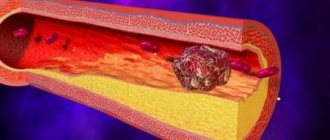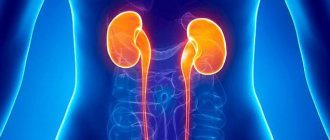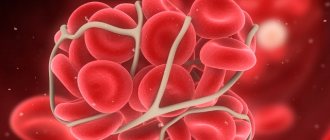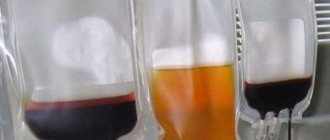Clinical manifestations of thrombophlebitis
Thrombosis in pregnant women, unfortunately, often occurs. This is facilitated by changes in the composition of the blood; during pregnancy it thickens. Thrombosis of the lower extremities occurs most often.
In the second half of pregnancy, when the uterus grows at double the speed and the fetus puts pressure on the vessels of the legs, the likelihood of blood clots increases significantly.
Thrombophlebitis is usually a consequence of varicose veins. Blood clots form in dilated vessels.
This is dangerous because the blood clot can break off and begin to move through the vessels. If it gets into the heart, a heart attack is possible, and if it gets into the brain, then a stroke.
Therefore, at the first manifestations of varicose veins, it is necessary to immediately begin treatment in order to prevent thrombosis. It is important to understand that the formation of a blood clot is dangerous for both the life of the mother and the life of the baby.
Thrombosis and thrombophlebitis - what is it?
Thrombosis and thrombophlebitis are vascular diseases in which blood clots form in the veins and blood circulation is impaired. The diseases primarily affect the lower extremities and have a similar etiology, but the symptoms of the pathologies are somewhat different.
| Characteristic | Thrombosis | Thrombophlebitis |
| Localization location | Deep veins | Superficial and deep venous vessels |
| Where do blood clots form? | In normal or inflamed vessels | Only in deformed vessels |
| Main cause of the disease | Violation of blood coagulation properties | Vascular damage |
Thrombosis is considered a more dangerous disease, since there are no obvious inflammatory processes, the symptoms are mild, which greatly complicates timely diagnosis.
Thrombophlebitis is inflammation in vessels affected by varicose veins; the disease has a pronounced clinical picture.
Types of thrombophlebitis and its symptoms
Thrombosis can be deep veins of the leg and ophemoral (ilio-femoral).
In this case, the woman experiences the following symptoms:
- heat;
- sensation of goosebumps on the skin;
- numbness of the limb;
- headache;
- increased fatigue;
- diarrhea;
- nausea;
- severe pain in the leg.
The sore leg swells greatly, it becomes very hot to the touch or, on the contrary, too cold. The skin of the limb in which the thrombus is located has a special, shiny appearance.
The pulse may increase greatly and you may feel weak. The veins on the sore leg are clearly visible, and the vascular pattern is clearly visible. Sometimes the limb with the blood clot appears blue.
Acute thrombosis during pregnancy is an indication for mandatory hospitalization of a woman.
If such symptoms occur, you should immediately contact a medical facility. Only at the first signs of the disease can the life of the mother and baby be saved.
Clinical picture
Surely every woman has an idea about this disease. The etymology of the disease is due to the formation of a blood clot in the vessels, which poses a threat to the unimpeded movement of blood. In most cases, blood clots appear due to a violation of the integrity of the vessel walls. But there are known situations for diagnosing the disease with intact vessels.
A clot that moves freely through a vessel is called an embolus. Obstruction of more than 75% of the free lumen of the vessel limits the flow of necessary nutrients through the blood to tissue cells, resulting in hypoxia. Further maturation of the blood clot provokes the death of vascular cells. Therefore, thrombosis is a dangerous venous pathology of the deep veins and veins of the lower extremities. Her connivance entails irreversible consequences.
In most cases, thrombosis in pregnant women is caused by damage to the veins of the lower limb, vena cava or hemorrhoid. Thrombosis during pregnancy of deep veins provokes compression of the inferior vena cava, leading to its enlargement.
Reasons for its development
In order for thrombophlebitis to develop in a pregnant woman, several factors must be present:
- phlebeurysm;
- inflammatory process;
- blood thickening.
Due to increased sex hormones, blood becomes thicker during pregnancy. Prothrombin and fibrinogen in the blood increase. In addition, the fetus puts pressure on the lower limbs, as a result of which blood circulation deteriorates.
The vessels dilate and the blood flow in them is disrupted. And if a woman is still rapidly gaining weight, this process becomes more complicated.
Other aggravating factors are:
- the age of the pregnant woman is over 35 years;
- taking oral contraceptives for a long time before pregnancy;
- the presence of autoimmune diseases (lupus erythematosus, etc.);
- multiple births (more than four);
- inherited lack of antithrombin;
- nephropathy;
- being on long-term bed rest;
- homocystinuria;
- serious injuries in the past;
- history of thromboembolism.
All this provokes the development of the disease, and if thrombosis occurred before pregnancy, then the risk of complications increases many times. Cardiovascular diseases of the pregnant woman, working on one’s feet, infectious diseases, and taking glucosteroids also affect the formation of a blood clot.
How does thrombophilia affect pregnancy?
Potentially dangerous manifestations of thrombophilia can appear from the first days of gestation. These include:
- increased blood pressure due to increased blood viscosity;
- early toxicosis, expressed by nausea, uncontrollable vomiting. Dizziness and fainting;
- swelling of the legs due to impaired blood supply;
- intestinal colic that occurs against the background of intestinal vascular thrombosis.
The listed symptoms do not pose a mortal threat to the child, but significantly worsen the well-being of the expectant mother.
If thrombophilia is not detected in time, the risk of blood clots forming in the vessels of the heart, uterus and placenta itself increases. Such conditions are accompanied by shortness of breath, increased fatigue, pressing pain behind the sternum and lower abdomen. These symptoms should prompt a thorough examination by a hematologist. When blood clots form in the placenta, there is a significant threat to the condition of the fetus. Receiving less nutrients and oxygen, it is exposed to hypoxia. Because of this, abnormalities in the baby’s activity may be observed: excessive mobility or freezing, increased or slowed heartbeat of the fetus. With prolonged hypoxia, developmental delay inevitably occurs, and in especially severe cases, the formation of congenital defects of the brain, heart and other organs.
Due to the increased risk of congenital fetal defects, thrombophilia in obstetrics and gynecology is sought to be identified even before pregnancy or in the first weeks of gestation.
Why is thrombophlebitis dangerous during pregnancy?
Thrombophlebitis is an extremely dangerous disease during the fruiting period. The formation of a blood clot threatens with such deadly consequences as: heart attack, stroke, thromboembolism. Placental abruption is also possible, which is a life-threatening condition.
The life of the pregnant woman and the child depends on timely assistance. It is necessary to start treating this disease the sooner the better.
But not everyone knows which doctor to contact if they suspect thrombosis. If the pregnant woman’s condition is not critical, then you can see a gynecologist who is managing the pregnancy. But if the temperature rises, the pain in the leg becomes very severe, and obvious swelling occurs, then you cannot hesitate, you must urgently call emergency help. This condition is extremely dangerous for mother and child.
Diagnosis of thrombosis in pregnant women
Symptoms of thrombosis most often appear during pregnancy:
- leg swelling, redness, increased temperature at the site of swelling, pain in the groin, indicate thrombophlebitis;
- acute, “explosive” pain in the frontotemporal part of the head - a manifestation of cerebral venous thrombosis;
- throbbing acute pain in the abdomen - damage to the renal or inferior vena cava;
- nausea, dizziness, sharp throbbing abdominal pain, chills are symptoms of a blood clot in the uterus.
The diagnosis is made based on the results of examination, questioning, instrumental and laboratory tests.
To determine blood composition and hemodynamics, a coagulogram is performed.
Determine the necessary indicators:
- APTT (activated partial thromboplastin time) - study of coagulation efficiency;
- D-dimer is a protein particle that is present in the blood after the breakdown of a blood clot;
- prothrombin index - analysis for the determination of prothrombin. Prothrombin is a precursor protein for thrombus formation;
- fibrinogen is a protein produced in the liver. It is converted into fibrin, the insoluble basis of a blood clot;
- platelet aggregation is a stage of hemostasis at which platelets exhibit the ability to adhere to the walls of blood vessels and to each other.
Instrumental diagnostic methods:
- echography of leg veins;
- dopplerography;
- phlebography - indicated in the postpartum period;
- MRI.
Based on the data received, the specialist makes his conclusion.
Diagnostics
After a pregnant woman comes in with suspected thrombophlebitis, the doctor will prescribe an examination. Perhaps the gynecologist will invite a vascular surgeon to examine the woman. An external examination and palpation of the limbs is carried out.
A blood test is ordered for:
- coagulogram;
- prothrombin;
- fibrinogen;
- APTT;
- D-dimer;
- prothrombin time.
An ultrasound examination of the fetus and vascular Dopplerography are also required. Phlebography is sometimes prescribed, although some doctors are categorically against this procedure. If a pregnant woman has dropsy, osteoarthritis, venous insufficiency or polyarthritis, then differential diagnosis is carried out.
Diagnostic methods
Diagnosis of thrombophlebitis is usually not difficult. The doctor finds out the patient’s complaints, collects anamnesis - how and when the first symptoms appeared, whether such a disease existed before. An objective examination provides enough data to make a diagnosis of thrombosis, but additional laboratory and instrumental studies are carried out:
- General clinical blood tests. An increase in the number of platelets and a violation of the coagulation system are detected. Clotting time is assessed
- Dopplerography. The method allows you to accurately assess the condition of the veins, identify disturbances in blood flow,
- Ultrasound of the fetus. Necessary to assess the vital activity of the fetus and exclude hypoxia. For the same purpose, a method such as cardiotocography is used.
Invasive diagnostic methods (phlebography) are not recommended for pregnant women.
Features of treatment
When the diagnosis is confirmed, the pregnant woman is urgently sent to the hospital. This disease cannot be treated at home. She must observe strict bed rest to prevent the possibility of thrombus migration.
The woman’s legs should be elevated, a special compression of the limbs is created. The choice of treatment method for thrombosis in pregnant women is made by the attending physician. This may be a surgical method or conservative therapy, depending on the severity of the process and the patient’s condition.
Drug therapy
The fact is that many drugs for the treatment of thrombophlebitis are prohibited during pregnancy. Indirect anticoagulants should not be used by pregnant women. Therefore, the doctor selects individually safe products for a specific case.
Usually for thrombophlebitis the following are prescribed:
- heparin (intravenously);
- acetylsalicylic acid;
- pentoxifylline;
- antibiotics;
- venotonics;
- non-steroidal anti-inflammatory drugs (for pain).
Conservative treatment usually lasts two weeks, after which a control coagulogram is required. After the condition improves and the tests normalize, the patient is discharged. At home, a woman must follow a diet.
Excluded from the diet:
- spicy dishes;
- roast;
- salty;
- fat;
- sweet;
- fast foods;
- seasonings;
- cakes.
It is necessary to observe the drinking regime, drink up to 2 liters of clean water per day. It is useful to walk in the fresh air, avoiding overwork. Sleep at night should be sufficient, and it is also good to take a nap during the day.
Drug therapy is carried out under the supervision of the attending physician.
You should definitely wear special compression stockings; your doctor will help you decide. At the same time, special ointments for the legs should be applied daily, which improve blood circulation, strengthen the blood vessels of the legs, prevent blood clots and eliminate swelling.
Traditional medicine can be used as an aid. Honey compress is useful: 2 tablespoons. honey mixed with half a spoon of olive oil.
Apply the mixture to the leg, wrap it with gauze, and cover it with cellophane film. Leave the compress overnight and wash off in the morning with warm water.
Cabbage leaves are also useful; they should be washed, mashed, and tied to the leg with a bandage at night. There are other methods of alternative treatment for thrombophlebitis. It must be remembered that all products must be discussed with a doctor before use.
Surgical intervention
In difficult cases, if a migrating blood clot is detected, urgent surgery is indicated. To do this, a vena cava filter is inserted into the inferior vena cava under local anesthesia. Modern medicine also has other surgical methods for treating acute thrombosis. Anticoagulant treatment is necessary after surgery.
Treatment methods
If dangerous symptoms appear, be sure to contact a phlebologist; after the examination, the doctor will prescribe additional tests - a general blood test to determine blood clotting time, Doppler ultrasound to determine the severity of circulatory disorders, the presence of blood clots.
An additional ultrasound of the fetus is required to rule out hypoxia.
It is difficult to treat thrombosis during pregnancy, since most drugs are not suitable for expectant mothers. Therefore, they use an integrated approach, which includes diet, adherence to a daily routine, and taking approved medications and folk remedies.
How to treat thrombosis during pregnancy:
- Detralex, Phlebodia - safe venotonics, strengthen vascular walls, eliminate swelling, thin the blood;
- Ibuprofen, Diclofenac - anti-inflammatory drugs are prescribed for severe pain;
- Curantil is an anticoagulant that prevents the formation of blood clots;
- Ascorutin, Aescusan - drugs strengthen blood vessels, making them more elastic.
Despite the fact that all drugs are considered safe, they should not be taken without a doctor’s prescription.
In severe cases, in the absence of effect from conservative therapy, surgery is prescribed - phlebectomy, the affected vein is removed. If relapses occur frequently, a special filter is installed in the vena cava.
The influence of thrombophlebitis on childbirth
If thrombophlebitis was diagnosed in the first trimester, then pregnancy can be maintained provided that an x-ray was not taken. In the second and third trimesters, pregnancy can be maintained if there are no other obstetric contraindications.
If there is no likelihood of pulmonary embolism, then vaginal delivery is possible. But most often, with thrombophlebitis, delivery is performed by cesarean section.
It should be taken into account that intravenous heparin is stopped 6 hours before birth. Treatment with these drugs can be continued only 6 hours after birth. If a moving blood clot is detected, then childbirth is possible only after installing a vena cava filter.
If it was not installed in time, a caesarean section is performed with preliminary suturing of the vena cava. Before this, antithrombotic therapy is carried out.
Thrombophlebitis and pregnancy - is it possible to become pregnant and give birth with venous pathologies?
Thrombophlebitis is not a contraindication for natural childbirth, but only if the disease is at an early stage of development.
Natural childbirth is possible if the woman followed all the doctor’s recommendations - wore compression garments, took phlebotonics and anticoagulants. The day before giving birth, you should stop taking blood thinners to avoid heavy bleeding.
If there are several blood clots, a cesarean section is performed to avoid serious complications for mother and baby.
Pregnancy with thrombosis is quite possible; the disease does not affect conception in any way. But it is better to visit a doctor, undergo a full examination and treatment at the planning stage. Since there is a high probability of exacerbation of venous pathologies in expectant mothers, prepare yourself in advance for frequent visits to specialists; you may have to go to the hospital several times.
Is pregnancy possible with thrombosis?
The disease itself is not a contraindication to fruiting. Provided proper management of pregnancy, careful monitoring throughout the entire period, and compliance with all doctor’s recommendations, a successful outcome of labor and the birth of a healthy child is possible.
Before and after childbirth, for thrombophlebitis, venotonics are prescribed, mandatory wearing of compression stockings, and the correct daily routine. Treatment with anticoagulants is carried out as prescribed by the doctor. If a pregnant woman’s condition worsens, she should immediately see a doctor.
Prevention of pathology in pregnant women
A few simple rules will help protect against thrombosis:
- food should be healthy, enriched with vitamins. It is forbidden to consume fatty, smoked, canned foods and food containing preservatives;
- shoes and clothes - do not restrict movement, do not press. Jeans, trousers, skirts that compress the lower abdomen are unacceptable during pregnancy, even in the first month. They should be replaced with maternity dresses and overalls;
- physical activity - no long static positions standing or sitting. If the job is sedentary, every hour you need to get up and warm up - stretch, bend over, walk around;
- warm baths - sitz baths, foot baths are prohibited;
- Wearing compression garments will prevent the development of complications with visible varicose veins.
If a woman is worried about whether she can give birth with thrombosis diagnosed during pregnancy, she should calm down - the risk of complications is quite low.
In most cases, it does not pose a danger to the fetus and mother. Timely detection of pathology in itself is a deterrent.
Following medical instructions will help the expectant mother maintain her health and give birth to a healthy baby on her own.
Author: Irina Petrovna, obstetrician Specially for the site kakrodit.ru
Prevention
In order for your pregnancy to go smoothly, you should follow some preventive measures:
- do not lift heavy objects;
- perform special exercises;
- wear compression stockings throughout pregnancy;
- take venotonics;
- walk outside every day;
- do not overwork, follow a daily routine;
- quit bad habits;
- eat right;
- observe the drinking regime.
To prevent thrombosis during pregnancy, you should exclude everything salty, fatty and smoked from your diet. Dishes should not be fried, but boiled or smoked. You shouldn’t get carried away with ice cream and cakes, and you shouldn’t drink soda. You need to eat more fresh vegetables and fruits.
As prescribed by the doctor, you must take preventive medications. It is important to understand that your own health during this difficult period of life and the health of your baby depends only on the pregnant woman herself, on her attention to herself and the correctness of following the recommendations.
There are many traditional medicines that thin the blood and prevent the formation of blood clots, but they should not be used independently. Because they reach the fetus through the umbilical cord and can adversely affect the fetus. The use of all folk remedies should be carried out only with the permission of the attending physician.
Treatment
The process of treating the above disease has a specific goal, namely the restoration of blood flow through the veins.
The complex of therapy can be:
- Medication
- Without the use of medications
The first option is considered very extensive and depends on many factors.
The second option is a mandatory transfer of the pregnant woman to the inpatient surgical department, where she is prescribed special procedures, in particular strict bed rest in combination with elastic compression of the legs, as well as their constant elevated position.
We should talk more seriously about the treatment that is carried out with the use of certain medications. Typically, a medical representative prescribes heparin in a certain dosage. Thus, the process continues until the goal is achieved - an increase in APTT. This therapy usually continues for two weeks. After this, there is the option of transferring the patient to low-molecular-weight medications. Also, acetylsalicylic acid is prescribed, which improves microcirculation, as well as the rheological characteristics of the blood.
Development factors
The appearance of blood clots in pregnant women is caused by several factors:
- varicose pathology with expansion of internal veins;
- coronary disease, other cardiac disorders;
- hypertension;
- hematological diseases;
- low mobility;
- long-term bed rest for a woman who is conserving her unborn child;
- a sharp increase in intra-abdominal pressure;
- previous mechanical trauma to blood vessels;
- genetic characteristics;
- long-term use of certain drug groups;
- high cholesterol.
Latest information: Troxevasin for varicose veins, instructions for useTroxevasin for varicose veins, does the drug help?
There are other known causes of blockage of the inferior vena cava, as well as disturbances in the venous blood flow of deep vessels. Thrombosis of the inferior deep vena cava or hemorrhoidal node is monitored by a specialist. This type of illness causes equal harm to mother and child.
Physiological characteristics are known that have a negative impact on the condition of the veins of expectant mothers. Among the most common cases, compression of the veins of the pelvic area by the fetus's head is noted. The result of this effect is an increase in venous pressure.
It is necessary to take into account and, if possible, suppress factors that provoke the appearance of blood clots. Thrombosis negatively affects the mother’s well-being and poses a risk to the development of the fetus.
Important! Phlebologists have established the fact that the likelihood of thrombosis in pregnant women increases. The risk group consists of people who are overweight, over thirty years of age, and having given birth for the fifth time or more.
For pregnant women with these characteristics, doctors prescribe monitoring the condition of the veins with ultrasound once every trimester. Additional recommendations include physical therapy, proper nutrition, and wearing special compression stockings, which can be done at home.
What kind of pathology
Thrombophlebitis is inflammation of the vascular walls with the formation of a blood clot. The clot interferes with normal blood circulation and can break off at any time.
The disease develops in the presence of 3 main provoking factors. Changes in the hematopoietic system and blood clotting, varicose changes in the vascular walls, inflammatory process.
What is dangerous for mother and baby
When the veins become inflamed, blood flow is disrupted, which prevents oxygen from reaching the baby. Against the background of hypoxia, developmental pathologies and congenital diseases develop.
Thrombophlebitis during pregnancy - what is dangerous and its consequences:
- acute venous insufficiency;
- thromboembolism;
- phlebitis;
- trophic ulcers;
- formation of a floating thrombus; if a clot occurs in the umbilical cord, this can lead to intrauterine fetal death.
When the lower extremities are affected, sepsis often occurs, and the risk of vena cava thrombosis increases.
Types of disease
Thrombophlebitis is divided into several groups, depending on the origin, location of the inflammatory process, and area of damage.
By affected area:
- deep vein thrombophlebitis - inflammation most often occurs in the femoral vein, or in the internal organs;
- superficial thrombophlebitis - the vessels that are located near the skin become inflamed.
By affected area:
- local inflammation - the pathological process occurs at the site of attachment of the blood clot;
- migrating inflammatory process - subsides in one place, moves to another area, the disease quickly progresses.
Depending on the reasons:
- varicothrombophlebitis;
- post-injection thrombophlebitis;
- septic or infectious;
- aseptic.
Depending on the size of the blood clot:
- occlusive - against the background of blockage of the vessel, blood flow slows down significantly;
- ischemic - severe swelling and thrombus leads to complete blockage of the lumen of the vein, blood does not flow to the tissues, necrosis develops;
- non-occlusive - the thrombus does not interfere with normal blood flow.
Inflammation of the veins occurs in acute or chronic form.
Postpartum thrombophlebitis
Thrombophlebitis can develop in a woman not only during childbirth, but also after it. It usually begins 2-3 weeks after birth and can spread from inflamed veins in the uterus. Often a young mother complains not only of pain, but of chills, general deterioration of her condition, and fever. However, these are symptoms not of a cold, but of thrombophlebitis, which cannot be ignored.
Thrombophlebitis is undoubtedly one of the most serious complications of varicose veins. However, knowing about its symptoms, the disease can be detected in time and measures can be taken. Be attentive to yourself, and this will help you maintain the beauty and health of your feet for a long time!
Why does it occur
An increase in blood viscosity in pregnant women is a natural process. This is necessary in order to reduce blood loss during childbirth.
There is a high likelihood of blood clots occurring in the third trimester. At this time, the female body begins to actively prepare for childbirth.
Pregnancy puts additional stress on the female body. Special physiological changes occur in it.
They have a more negative effect on blood vessels than a positive one. Intrauterine pressure increases, and the vessels of the lower body suffer.
Deep vein thrombosis is especially dangerous. At any moment it can lead to death.
Symptoms and treatment
Thrombophlebitis is a disease that requires immediate response. Firstly, the patient’s quality of life depends on it. Secondly, such an illness can lead to very sad consequences, even death. If the problem was not noticed at the initial stages of its development, then it will develop into deep vein thrombosis, and during pregnancy it is difficult to solve this issue. This is due to the fact that carrying out any surgical interventions (at any time) can lead to interruption of pregnancy.
To avoid such a situation, every woman should know the symptoms of the disease. If this is an acute phase, then it will manifest itself with the following signs:
- sharp pain that “stretches” throughout the vein;
- if you squeeze the calf muscle or stand on the sore leg, shooting pain appears;
- seals or lumps may be observed on the affected vein;
- the sore leg begins to swell at times;
- in some cases, temperature appears (37-38 degrees);
- The skin may also turn red.
If suddenly such symptoms of thrombophlebitis appear during pregnancy, you should immediately go to see a specialist. The sooner you tackle the problem, the easier it is to solve it and you will be able to avoid consequences with complications.
As for the treatment of thrombophlebitis in pregnant women, a very careful approach is needed. The fact is that most drugs easily penetrate the placenta, which means they can harm the fetus. Therefore, the woman will have to be constantly monitored by a phlebologist, who will monitor her condition and, if necessary, adjust therapy.
The main goal of treating thrombophlebitis during pregnancy is to restore normal blood flow through the veins. The doctor will have to assess the degree of risk, take into account the period and characteristics of gestation, and also analyze existing diseases. It happens that a woman is urgently placed in storage.
If a pregnant woman’s disease is in an acute stage, then she begins to be treated conservatively. For these purposes, the expectant mother is individually selected for compression garments and sent to a massage course. During rest, she should use bolsters or pillows under her feet to relieve them as much as possible. Compresses based on Troxevasin, Phenylbutazone and heparin ointment cope well with the acute stage.
As for medications, thrombophlebitis during pregnancy can be treated with the following drugs:
- non-steroidal anti-inflammatory drugs that promote red blood cell adhesion - Teonicol, Diclofenac, Aspirin and Butadione;
- drugs that dissolve a blood clot even at the stage of its formation - “Urokinase”, “Trypsin”, “Streptokinase”, “Chymotrypsin” and “Fibrinolysin”;
- medications that will restore vascular tone - “Troxevasin” and “Eskuzan”;
- antihistamines - Tavegil, Suprastin, Pipolfen and Diphenhydramine.
Only a doctor can calculate the dosage and duration of use, as he will be able to focus on the health condition and understand how not to harm the baby.
Latest information: Diet for varicose veins1 What to avoid2 Useful substances for varicose veins3 The healthiest foods4 Juice diet
Unfortunately, thrombophlebitis of the lower extremities during pregnancy has complications. In this case, the woman may be prescribed a course of injections of Heparin, Fraxiparin, Troparin, Fragmin or Clexane. Electrophoresis is also used as an additional method of assistance. In any case, the success of recovery directly depends on how carefully the woman pays attention to all the doctor’s instructions and whether she follows them.











